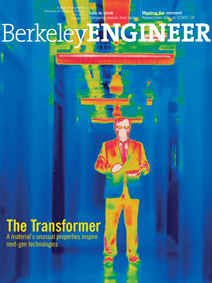Game-changing metalens
The size and weight of optical lenses have presented significant obstacles in the effort to miniaturize optoelectronics and other devices. But researchers led by Boubacar Kanté, associate professor of electrical engineering and computer sciences, have created an ultrathin, flat optical metalens whose performance rivals that of bulkier, traditional lenses on the market — and could lead to game-changing advances in solar energy, virtual reality and medical imaging.
Traditional lenses are usually made with bulk materials and curved surfaces to bend and focus incoming light waves. Such lenses are able to capture 65–75% of the incident light but are heavy and susceptible to chromatic aberrations. Flat lenses — which use engineered designs and metamaterials to bend light — can manipulate light at subwavelength scales and overcome chromatic aberrations, but only in a very narrow band of light. And going flat has often meant sacrificing performance: previous metalenses delivered lower efficiencies of 20–40% in lenses measuring 600–800 nanometers thick.
To improve light-capturing capabilities, the researchers used electron-beam lithography to shape a fishnet pattern onto a titanium dioxide wafer. To mimic the curvature of a traditional lens, they used a gradient in which smaller holes were formed in the center and larger ones were positioned around the edges. Their fishnet-achromatic metalens, measuring 350-nanometers thick, was able to capture 70% of incoming light in frequencies ranging from 640 nanometers (reddish-orange light) to 1200 nanometers (infrared light). Light entering the fishnet metalens within that broad octave band of wavelengths can be focused at a single point on the other side of the lens.
Read more: Engineers create game-changing metalens that breaks records in performance


